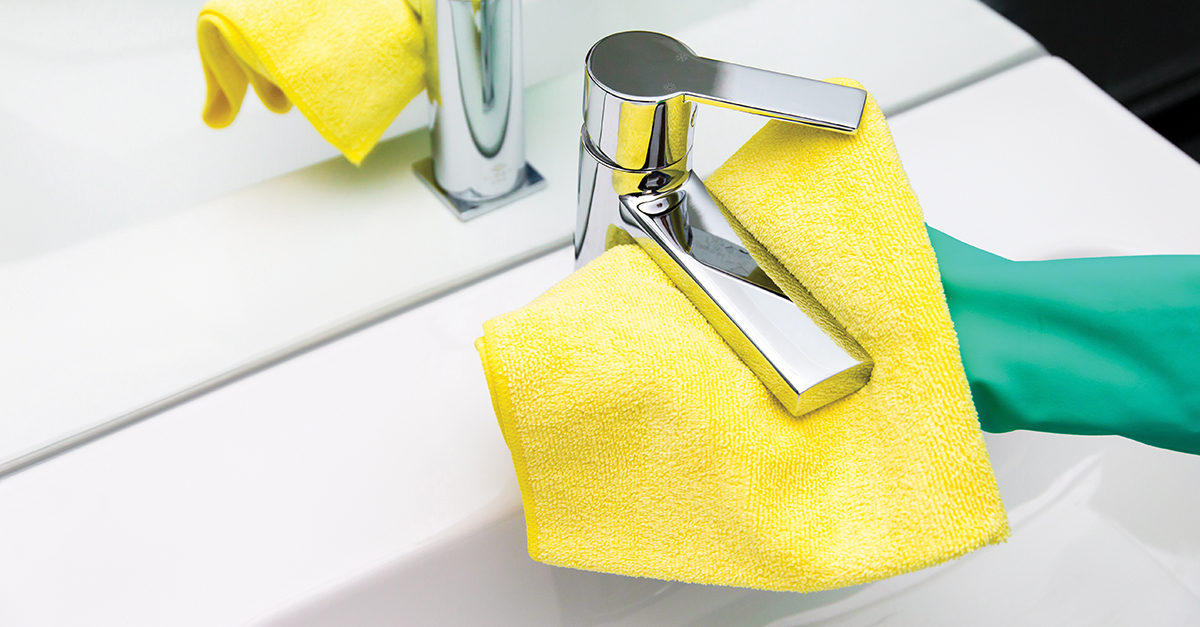When it comes to finding the right traditional chemical disinfectants, the marketplace tends to rely on products registered with the U.S. Environmental Protection Agency (EPA); these products are guaranteed to be effective at killing the germs they target.
However, as new on-site generation technologies emerge that also claim to have disinfecting properties, the old standby of EPA registration isn’t always cut and dry. That’s because many of these technologies don’t produce a traditional product that facility managers and building service contractors (BSCs) can find on the shelf. Rather, they are machines that convert water into cleaning and disinfecting solutions on the spot—also known as on-site generation.
This article will help to explain on-site generation, the way the EPA has registered on-site technologies in the past, and the way the EPA is starting to register some of those technologies now.
The 101 of On-site Generation
While on-site generation is often described as a new technology—and in the cleaning industry most of these products are relatively new to the marketplace—the science behind it is almost ancient history. “Electrolysis means simply to pass an electric current through water,” says John Shanahan, co-founder of GenEon Technologies, an on-site generation technology company based out of Texas. “That technology goes back to the 1870s. There’s nothing new about it.” Industry professionals also refer to this technology as electrolyzed water or electro-chemical activation.
The on-site generation technology connects to a tap water supply, drain, and standard electrical outlet. Softened tap water and a small amount of salt are combined and the mixture flows into an electrolytic cell. Water electrolysis creates two separate streams: a cleaning solution and a disinfectant. The solutions then dispense into spray bottles, automatic scrubbers, all-surface cleaners, and carpet extractors, where they are then ready for custodians to use them on surfaces.
On-site generation technology is perhaps best known for its sustainable properties, due to less packaging and the lack of shipping/transportation needs. They also claim to use less-highly concentrated chemicals that are safer for human and environmental health. As the EPA is beginning to work with on-site generation manufacturers to register their disinfectants, the marketplace will begin to see more and more of them with registration and kill claims.
“Our industry has traditionally used quats, bleach, phenolics, and recently AHP as active ingredients in conventional bottled disinfectants, and is often conservative and cautious about adopting new technologies,” says Reid Rabon, senior manager of technical applications for Orbio Technologies. “The ability to generate disinfectants through on-site generation has created new options for customers and there is interest in the marketplace.”
Rabon adds, “EPA registration of on-site generation technologies as devices, or registration of the electrolyte or output, is another indication that companies are seeing enough demand in the market to invest the time and resources to work through the EPA processes.”
EPA Establishment Numbers
There are a few levels of EPA registration to consider when trying to understand regulation of on-site generation technology.
First, you have the widespread registration of the on-site generation device as a pesticide product. According to a source at the EPA, “A pesticide product consists of a proprietary chemical used in conjunction with a device to produce an output to kill a pest. This entire system is registered.” However, it’s important to remember in this case, we’re talking about pests to public health—in other words, germs and microbes—not rodents or insects.
Regardless, any on-site generation technology is required to have an EPA registration establishment number, which is regulated under the Federal Insecticide, Fungicide, and Rodenticide Act (FIFRA).
Allen Rathey, president of the Healthy Facilities Institute, helps to explain how these EPA registration establishment numbers work. “An establishment number means the device claims to do something to a certain pest, microbe, or germ, and the EPA says to these manufacturers with the establishment number, ‘We expect you to maintain records that show that you do what you say you do.’”
According to the EPA, data from manufacturers supporting the product’s efficacy against pests is reviewed to ensure the product will control the pests listed on the label. The standards for antimicrobial pesticide products vary depending on factors such as the site use (e.g., household or hospital), type of microorganism (bacteria or viruses), level of kill, and claims that appears on the label (for example, claims that say a product is 99.99 percent effective).
EPA Registration of Disinfectants
Next, manufacturers may want to register the device’s end-product solution as a disinfectant, which is emerging as a new way, with a higher level of regulation, for companies to support their kill claims.
Disinfectants are solutions used to control microbial pests, such as viruses and bacteria. According to the EPA, “Any company that makes a product claiming to kill microbial pests must register it with the EPA and conduct studies to prove the ability of the product to kill these pests.”
However, until recently, the process has been tricky for on-site generation manufacturers to navigate, partly because their technology was so new to the field that the EPA was struggling to understand how it works. Since the solutions are not bottled or sold on their own, the EPA does not require them to be registered as a disinfectant.
The Registration Process
Registering a disinfectant solution with the EPA is a rigorous process that includes many fees, time to spare, a variety tests in third-party labs, and reams of data.
According to Rathey, the process can take anywhere between four and six months and costs a lot of money, with expenses including a fee to begin the process and then money for each test the company wants to conduct.
Shanahan can also testify to the expense of the process. “You have to test any bug or germ you want to claim,” he says. “And any time you do those tests, [they range] from US$8-20,000.” According to Shanahan, to achieve EPA registration as a disinfectant on GenEon’s own device, his company has already invested $350,000 in microbial testing.
“The term ‘EPA-registered’ has real meaning in the janitorial and environmental space,” Shanahan says, “When they [look] at devices, they said we can’t set up something lesser for them. It has to be equal for all.”
Benefits of Using Registered Products
Regardless of whether it’s required to register the end product as a disinfectant, the EPA registration is a valuable tool to help consumers understand where they can use a product, which microorganisms it can kill, and how to use it.
PathoSans, a division of Spraying Systems Co. that makes on-site generation technology, started the process of achieving EPA registration on its disinfecting solution about six months ago. “The EPA registration [of our disinfectant solution] validates that, yes it is considered an effective disinfectant,” says Laura Lois, business development manager at PathoSans. “Even though EPA registration is not required in order for people to use our product as a disinfectant, sometimes the state will decide they will not recommend a product if it’s not registered with the EPA.”
On-site generation manufacturers are optimistic about the EPA’s interest in registering their disinfectants at the same level that they register traditional chemical disinfectants. For these companies, it is a way to level the playing field and give end users more options beyond what has been traditionally accepted.
On-site Generation: Vetting Technology for Your Facility
Reid Rabon, senior manager of technical applications for Orbio Technologies, says, “If a facility is particularly concerned about efficacy against specific organisms, they should ask the chemical or device manufacturer for efficacy data and testing procedures.”
This data should be readily available to end users on the product label or manufacturers’ websites, Rabon adds. “The EPA requires that all efficacy testing be completed by an independent laboratory operating under good laboratory practices.” Therefore, when investigating on-site generation technology, facility managers and BSCs may want to ask whether or not the company or distributor selling to them has the materials to back up their claim.



